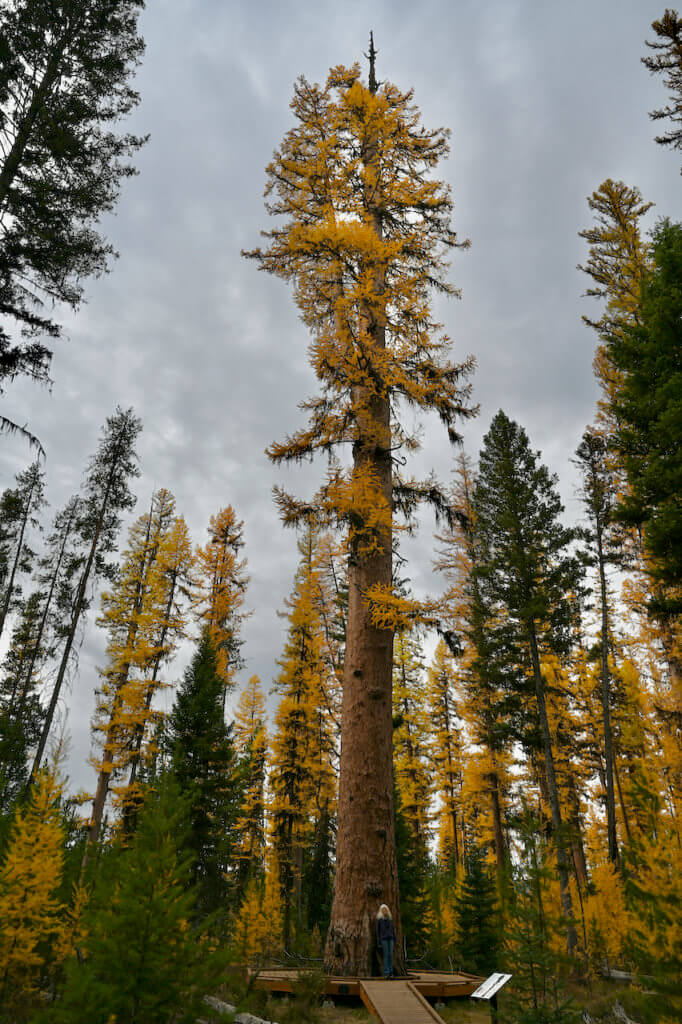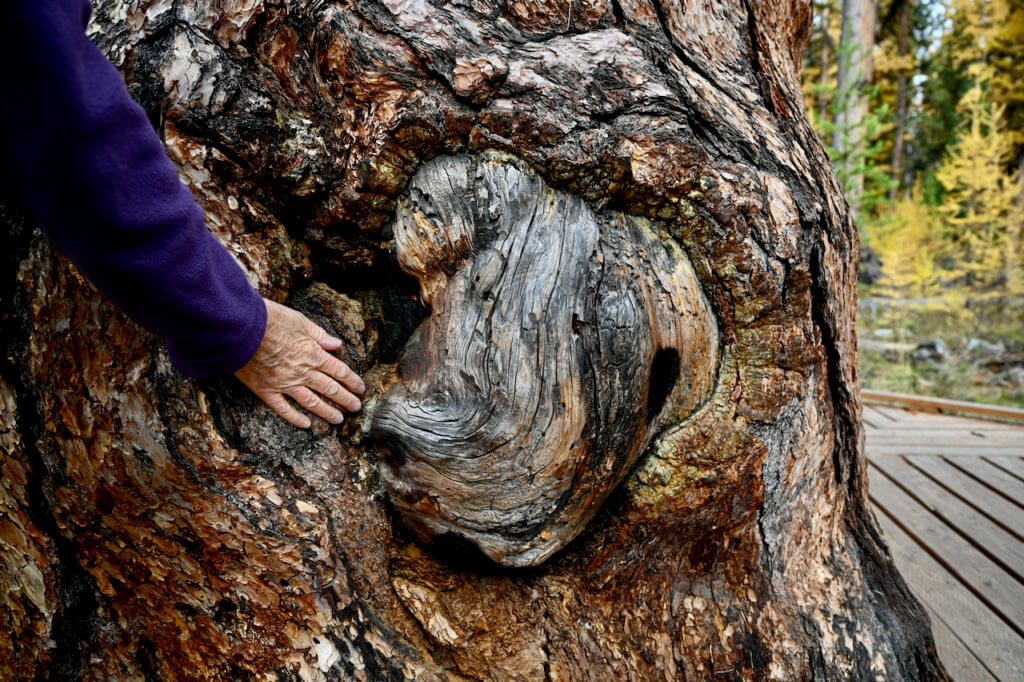Gus, the Champion Larch
by Jen Elison
Broadcast 10.19 & 10.22.2021

Gus in his autumnal splendor. Photo © Paul Robinson.
Listen:
Visitors to Montana’s Jim Girard Memorial Tamaracks Grove near Seeley Lake have differing reactions when viewing Gus for the first time. I was awed by the 163-foot height, craning my neck to see the very tippy top and then tilting back even further to view the additional 10 feet of dead tree top. A young woman paced backwards some 110 feet to accommodate Gus’s entire stature in her camera phone. One visitor wiped away tears of joy as she tried to wrap her arms around Gus’s 273-inch circumference. An Oregonian shared that she was not particularly impressed by Gus’s height as she was used to seeing the tall fir trees near Arcadia Beach State Park. Another visitor slowly circumnavigated Gus, fingering the large, corky, puzzle-like pieces of bark, layered some three to six inches thick, with rich colors ranging from black and gray to burnt umber and burnt sienna. A small child crouched to fit inside the fire-blackened hollow near the tree’s base, mimicking a Hobbit. Whatever the reaction, a visit to Gus is most certainly memorable.
Two feet taller than the Statue of Liberty, Gus was awarded the prestigious title “Largest Larix occidentalis (Western Larch) Tree in the United States” by the National Register of Champion Trees in 2020. And, while I admire the height and circumference of this majestic tree, I’m most in awe of Gus’s longevity. While visiting the Seeley Lake Ranger Station this summer, I learned that the average age of the larches located in this old-growth larch forest is 600 years. But, if there were a Guinness Book of World Records for western larch longevity, Gus, who has rotated around the sun 1000 times, would most certainly win the title.
Arborists studying mortality data would predict long lives for western larches. Over the centuries, this ancient species has adjusted in clever ways to be both fire resistant and fire adaptive. An informative plaque in the Girard Grove entitled “Tips for Living 1,000 Years” describes the unique adaptive qualities of the western larch. The thick, puzzle-shaped bark contains little resin and provides an impressive protective heat shield for the tree trunk. And the reason that Gus’s visitors need to tilt their heads back so far to see the tree’s crown reflects other adaptations. The living limbs rise high above the reach of flames, and the open crown provides ventilation, allowing the intense heat of a fire to rise above the treetop rather than setting the needles aflame.
It may seem contradictory that a tree can be both fire resistant and fire adaptive. Yet, western larches depend on fire to create soil rich in nitrogen to nurture fast-growing seedlings. The larch cones, found atop the trees’ tall crown, produce lightweight seeds that are easily dispersed to germinate on the newly burned, sun-drenched, mineral-rich earth.

A burl on Gus’s bark. Photo © Paul Robinson.
Western larch present another paradox in the world of conifers as their needles change color from light green to mellow yellow and shed in autumn, imitating their deciduous broadleaf cousins. While this display of fall color adds a glorious dappling of gold and green to the forests, it too is designed to protect the trees. According to Hailey Graf, Resource Conservationist with the Flathead Conservation District, the trees isolate nutrients (mostly nitrogen) from the needles for storage before they drop. This adaptation results in strengthening the tree and reducing the likelihood of heavy snow accumulation and lost branches. Producing new chartreuse needles each spring also protects them from insect infestation and fire.
A close examination of Gus’s trunk reveals the scars of time. Claw marks, large burls, and blackened scars bear witness to times of stress. The Forest Service estimates that Gus has survived 40 fires over the past 10 centuries, some started by Native Americans who lived in the region hundreds of years ago, and some started by lightning strikes. To me, these scars only add to the beauty and majesty of adaptation and living history. If Gus could talk, imagine the stories he would tell.
Every week since 1991, Field Notes has inquired about Montana’s natural history. Field Notes are written by naturalists, students, and listeners about the puzzle-tree bark, eagle talons, woolly aphids, and giant puffballs of Western, Central and Southwestern Montana and aired weekly on Montana Public Radio.
Click here to read and listen to more Field Notes. Field Notes is available as a podcast! Subscribe on iTunes, Google Play, or wherever you listen to podcasts.
Interested in writing a Field Note? Contact Allison De Jong, Field Notes editor, at adejong [at] montananaturalist [dot] org or 406.327.0405.
Want to learn more about our programs as well as fun natural history facts and seasonal phenology? Sign up for our e-newsletter! You can also become a member and get discounts on our programs as well as free reciprocal admission to 300+ science centers in North America!












